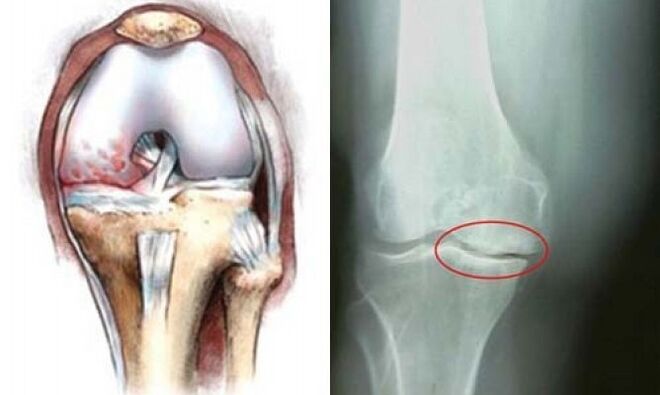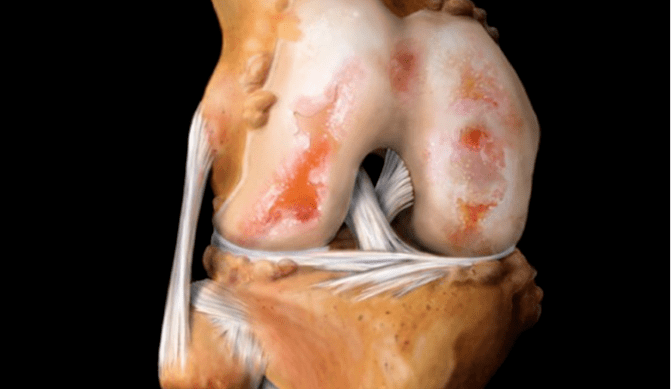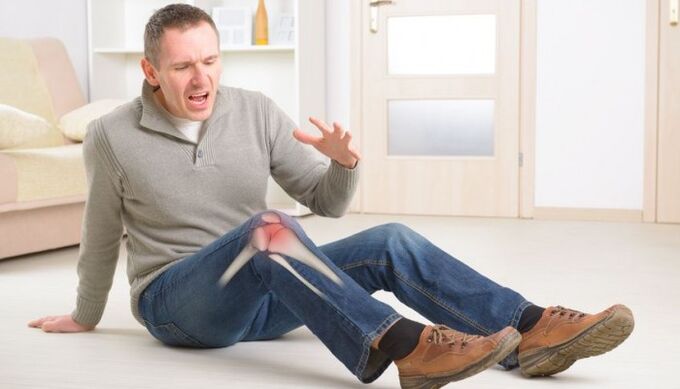Osteoarthritis of the knee joint is very common in the elderly, especially women. Young people are also diagnosed. This disease significantly reduces quality of life and can lead to disability if not treated properly.
How to recognize osteoarthritis? What are the causes of this disease? How can it be treated?
symptoms
Osteoarthritis is a damage to the hyaline cartilage of the joint. This cartilage is gradually destroyed. First, its structure and density change, then it becomes thinner. In severe cases, the cartilage may disappear completely.
There is always a strong enough load on the knee joint, because it is one of the major structural elements of the lower extremities. Therefore, the symptoms of osteoarthritis of the knee joint are also noticeable with minor damage to the joint.
Symptoms in knee osteoarthritis are associated with pain and gradual loss of knee function.
There are three stages in the development of the disease. Each of them has characteristic symptoms and requires appropriate treatment.
The first stage
The first stage can occur at different times in different people. In some, the joint changes progress rapidly, and after a few months the disease progresses to the next stage. In others, dystrophy of the cartilage structure occurs slowly, years after the onset of new symptoms.
Symptoms of the first stage of osteoarthritis of the knee:
- Intermittent pain in one or both knees. It usually occurs in the morning, when trying to take the first steps, when standing on one's feet for a long time, or when walking up or down stairs. The reason for a particularly obvious pain is to go down the stairs. There is no pain at rest.
- There are frequent complaints of a slight stiffness with intense movements in the joint area. However, no changes in the amplitude of movements are observed.
- There may be a small deformation due to the presence of fluid in the joint cavity, but the bone is not replaced.
All these symptoms indicate the need to consult a doctor. If you start treatment at this stage, you have a chance not only to stop the process, but also to begin the recovery process in some parts of the cartilage.
The second stage
If you do not consult a doctor, the disease progresses to the next, second stage. At the same time, the old symptoms worsen and additional complaints appear.
Signs of osteoarthritis in the second stage:
- The pain intensifies. Occurs with every movement of the foot. Anxiety is especially noticeable with long walks and lifting heavy objects. The pain gradually decreases during rest.
- When moving, there is pain and a crisis in the affected joint.
- The range of possible actions begins to decrease, which can be a cause for concern. When a person tries to bend his leg to the knee, he either fails or the bending causes severe pain.
- During the examination, the doctor notes small changes in the shape of the joints. If an X-ray is taken, it will be seen that the joint space is very narrow and that growths have formed at the edges of the bone.
- Large amounts of fluid can accumulate in the joint space. It can be detected during diagnostic procedures and during regular examinations.
Patients often consult a doctor at this stage. In this situation, it is very difficult to achieve a significant recovery, but some positive changes are possible.
The third stage

The third stage occurs with severe destruction of cartilage and is the most severe. Complaints and examination results of a patient with third-stage osteoarthritis:
- Severe, almost constant pain in the affected joint. As you try to move, you become stronger. At rest, even when lying down, the pain does not pass, so there are problems with sleep.
- Movement in the joint is severely limited.
- Often the knee "freezes" in a slightly bent position. This affects the shape of the foot and the patient's gait.
- Significant deformation of the joints and bones is observed during the examination.
- X-ray image shows the absence of cartilage in many areas of the articular surface, bone sclerosis. The joint space narrows sharply, and a large number of osteophytes are found.
These patients are especially difficult to treat. You may even need surgery.
Reasons
The causes of osteoarthritis of the knee joint are very different. In very rare cases, a person diagnosed with this disease has only one factor that causes the pathological process. In most cases, the changes in cartilage are due to a number of reasons. The higher the risk factors, the more intense the destruction and loss of functionality.
Arthritis is often triggered by the following features and conditions of the body:
- age-related changes in the structure of the musculoskeletal system;
- knee injuries, as well as operations that can lead to joint damage;
- excessive load on the lower extremities;
- congenital anomalies of the musculoskeletal system or metabolic processes;
- Inflammatory processes of various etiologies in the knee area.
Let's take a closer look at these causal groups.
Age changes

Osteoarthritis of the knee often develops after 40 years. This is due to the fact that at this and older age the structure of bone and cartilage tissue becomes more fragile, their resistance to stress decreases. Therefore, even long walks can be difficult to tolerate by the joints of the lower extremities.
Changes in the musculoskeletal system are especially noticeable in women during menopause.
During this period, estrogen levels, which previously protected bones from calcium loss, gradually decrease and become more sensitive.
Injuries and operations
Osteoarthritis can occur in young people as a result of trauma. This could be a broken leg, a dislocated knee, a torn ligament, or severe bruising. The longer it takes for the injury to be treated properly, the higher the risk of complications and osteoarthritis in the near future. Therefore, even with minor knee injuries, it is necessary to go to the hospital.
The risk of developing osteoarthritis after knee surgery is also high. Particularly dangerous is the removal of the meniscus. Osteoarthritis occurs in about 80% of patients after such an operation.
Traumatic osteoarthritis usually develops rapidly. Therefore, surgery may be required in such cases.
Overload
Excessive strain on the knees is observed in athletes who are professionally engaged in running, jumping, weightlifting. The older a person is, the more carefully he should choose physical activity options during training. Particularly dangerous for the knees are squats, sudden movements and running on paved roads.
People suffering from obesity are characterized by excessive tension in the joints of the legs. Then its own weight puts too much pressure on the cartilage and bones, causing them to wear out quickly.
Congenital pathologies

When there are pathologies in the musculoskeletal system and metabolic processes, it can also affect the knee joints.
Congenital pathological conditions with a high risk of developing osteoarthritis:
- anomalies of the knee joint;
- straight legs;
- violation of salt metabolism;
- ligament weakness.
If you are aware of such problems, it is important to pay special attention to knee pain, not to ignore them and try to work closely with doctors.
Inflammatory events
With arthritis of various etiologies, a large amount of fluid can accumulate. This leads to circulatory disorders, nutrient deficiencies in the bones and cartilage, and destruction of the structure of cartilage tissue. As a result, secondary osteoarthritis develops.
Inflammatory processes in the arteries of the legs that feed the knee are no less dangerous. When they are blocked by a thrombus, the blood supply is sharply reduced, which leads to degenerative processes in the cartilage.
Treatment
Therapy is determined taking into account the degree of development of the disease, its causes and the general condition of the body. Principles of treatment of osteoarthritis:
- reduction of pain;
- good supply of cartilage with nutrients;
- stimulation of recovery processes;
- an increase in the joint space to reduce pressure on the damaged cartilage;
- to strengthen and restore the function of the muscles surrounding the joint;
- maximum recovery of motor skills.
There are several treatment options for knee osteoarthritis. They usually include a set of therapeutic procedures.
What can be prescribed for the treatment of this disease:
- Therapeutic exercises. They are selected individually for each patient by an orthopedist. If you try to create a complex yourself, if you deal with pain, joint damage will progress.
- Diet.
- Surgery, prosthesis.
- Drug treatment: non-steroidal anti-inflammatory drugs (tablets or injections), painkillers, chondoprotectants, co-administration of glucocorticoids or hyaluronic acid.
- Additional procedures: hirudotherapy, massage, magnetotherapy, warming with paraffin or ozokerite, electrophoresis, manual therapy, etc.
If you feel joint pain, you should consult a doctor. Timely treatment is the key to successful treatment.


















